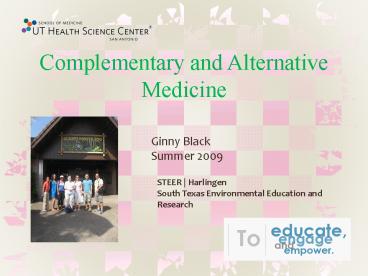Complementary and Alternative Medicine PowerPoint PPT Presentation
1 / 22
Title: Complementary and Alternative Medicine
1
Complementary and Alternative Medicine
Ginny Black Summer 2009
STEER Harlingen South Texas Environmental
Education and Research
2
Complementary and Alternative Medicine
- CA
CAM STATISTICS
- NHIS 2007 Results
- gt23,00 adults
- gt 9000 children
- Hispanic subpopulation
- administered by NIH/CDC
- Self report
- Interview one child if they are present
3
Complementary and Alternative Medicine
CAM STATISTICS
4
Complementary and Alternative Medicine
CAM STATISTICS
5
Complementary and Alternative Medicine
CAM STATISTICS
Mexican 18.2 Mexican American 27.4 Puerto
Rican 29.7 Dominican 28.2 South/Central
American 23.4
6
Complementary and Alternative Medicine
CAM STATISTICS
7
Complementary and Alternative Medicine
CAM STATISTICS
Echinacea and Ginseng were greatest in 2002
8
Complementary and Alternative Medicine
CAM STATISTICS
9
Complementary and Alternative Medicine
10
Complementary and Alternative Medicine
CAM STATISTICS
11
Complementary and Alternative Medicine
CAM STATISTICS
12
Complementary and Alternative Medicine
CAM STATISTICS
13
Complementary and Alternative Medicine
CAM STATISTICS
Children whose parents used CAM (23.9)
Adolescents aged 12-17 (16.4), compared to
younger children (7.6/10.7) White children
(12.8), compared to Hispanic children (7.9) and
black children (5.9) Children whose parents
had higher education levels (more than high
school 14.7) Children with six or more health
conditions (23.8) Children whose families
delayed conventional care because of cost (16.9)
14
Complementary and Alternative Medicine
CAM STATISTICS
Traditional healers visits in one year
812,000 Curanderos 21,000 Native American
Healers 224,000
15
Complementary and Alternative Medicine
The mission of NCCAM is to Explore
complementary and alternative healing practices
in the context of rigorous science. Train
complementary and alternative medicine
researchers. Disseminate authoritative
information to the public and professionals.
16
Complementary and Alternative Medicine
- What is CAM?
- CAM is a group of diverse medical and health care
systems, practices, and products that are not
generally considered to be part of conventional
medicine.
17
Complementary and Alternative Medicine
Complementary medicine is used together with
conventional medicine.
Alternative medicine is used in place of
conventional medicine.
Integrative medicine combines treatments from
conventional medicine and CAM for which there is
evidence of safety and effectiveness.
18
Complementary and Alternative Medicine
Mind-Body Medicine
Biologically Based Practices
Whole Medical Systems
Manipulative and Body-Based Practices
Energy Medicine
19
Complementary and Alternative Medicine
NCCAM has four primary areas of
focus Advancing scientific researchTraining
CAM researchersSharing news and
informationSupporting integration of proven CAM
therapies
We provide timely and accurate information about
CAM research via Web site information
clearinghouse fact sheets Distinguished Lecture
Series continuing medical education programs Pub
Med
20
Complementary and Alternative Medicine
Exercise is a proven CAM modality
21
Complementary and Alternative Medicine
BASIL
Ocimum Bacilicum
- Decreases platelet aggregation over a period of
3-7 days - Bacterialcidal but no evidence of an effect on
viruses or fungi - Fights Salmonella and staph
- Terpenoid effect- membrane disruption
- Essential oil
- NCI has determined it has cancer defending
properties
22
Complementary and Alternative Medicine
References
1) CAM Data Report Barnes PM, Bloom B, Nahin R.
CDC National Health Statistics Report 12.
Complementary and Alternative Medicine Use Among
Adults and Children United States, 2007.
December 10, 2008 2) Reference for Herbs Cowan,
Marjorie Murphy. Plant Products as Antimicrobial
Agents Clinical Microbiology Reviews, Oct 1999
p564-582 American Society for Microbiology 3)
Website for CAM www.nccam.nih.gov 4) Reference
for Herbs Craig, Wilson. Health Promoting
Properties of Herbs. American Journal of
Clinical Nutrition,1999, 70(suppl)491S-9S, USA,
American Society for Clinical Nutrition 5)
Reference for Basil Vieira, Roberto. Chemical
Characterization of Basil Found in Markets and
Used in traditional Medicine in Brazil, Economic
Botany 54(2) pp 207-216 2000 New York Botanical
Garden Press, Bronx, N.Y.
- CA

